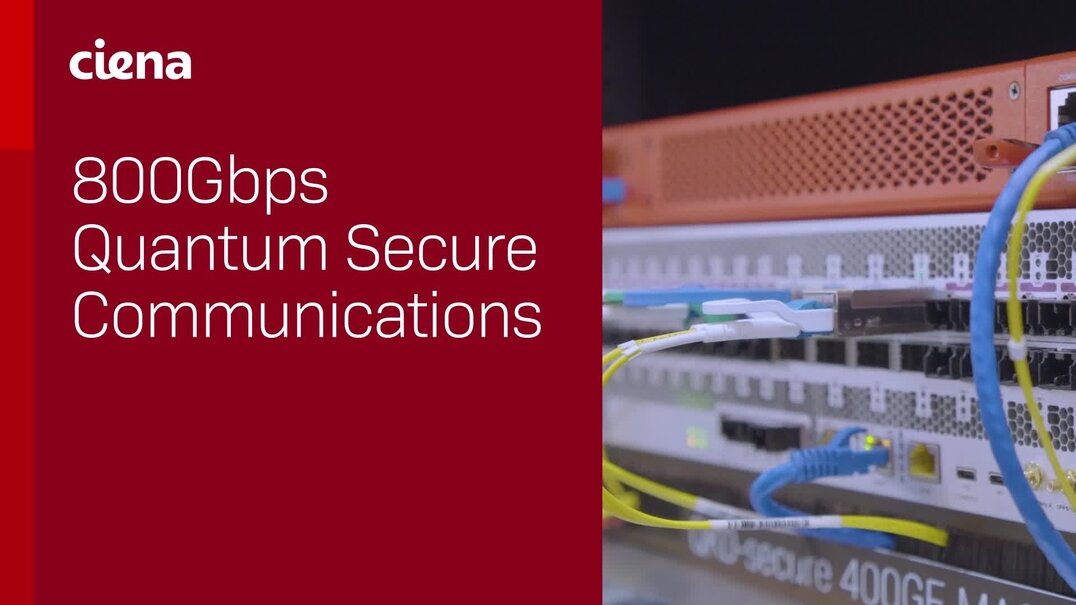Cable’s Fiber Outlook Survey – 87% Plan Aggregation in Outside Plant
The cable industry’s vision for delivering symmetric10Gbps networks was announced just over a year ago. To enable10G cable operators will deploy Distributed Access Architectures (DAA) and extend digital fiber nodes with Remote PHY and Remote MACPHY Devices (RPD/RMD). A foundational part of this transition is overhauling the access network between headends, hub sites, and RPDs/RMDs in the access network – a new Ethernet/IP network the industry refers to as the Converged Interconnect Network (CIN).
DAA further enables cable operators to virtualize legacy functions with cloud architectures, which in turn allows flexibility for software placement along different parts of the network, as needed. The cable industry is well positioned to leverage edge compute technologies to deliver innovative new services and revenue streams. But cable operators still have questions or decisions to make on items such as service convergence and key technologies for the CIN, field aggregation and coherent optics in the access, and automation before they can move forward on their DAA strategies.
Light Reading and Heavy Reading teamed up with SCTE/ISBE to produce the Cable 2019 Fiber Outlook Survey Report and to look at these very questions. Ciena partnered with Light/Heavy Reading on a new section to focus on DAA and the CIN. This online survey had over 200 responses from MSOs – 65% were from North America and 48% from operators generating $1B or more in annual revenues. Responses were primarily (64%) from executives in network planning, operations or engineering job categories.1
Important technologies for the Converged Interconnect Network
The Fiber Outlook Survey found that high-density packet aggregation with integrated optics, coherent optics solutions, and, intelligent automation are all important technologies for the CIN.
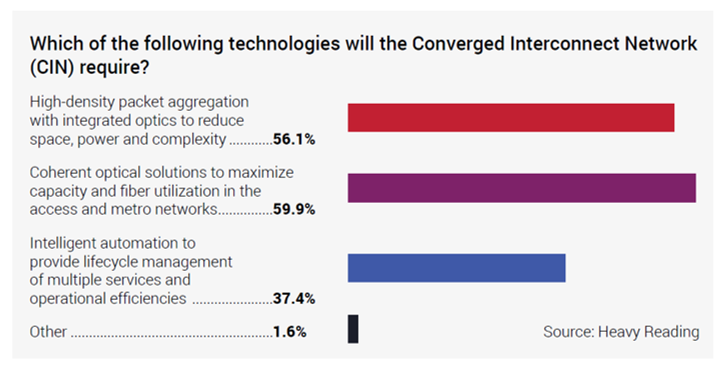
Ciena's Fiber Deep solution for the Converged Interconnect Network addresses these three technology areas enabling architectural and service convergence over a common CIN infrastructure. The benefits include:
- Maximizing capacity and fiber utilization in access and metro networks with industry-leading coherent optical solutions
- Reducing space, power and complexity via high-density packet aggregation with integrated optics
- Significant operational efficiencies with lifecycle management of multiple services
Field Aggregation Strategies
As cable MSOs extend fiber deeper into their networks, 10GbE traffic from RPDs/RMDs, as well as traffic from Passive Optical Nodes (PONs), mobile backhaul (MBH) and business services, will need to be aggregated for efficient utilization of scarce fiber resources. Aggregation in the access network can happen in the outside plant (e.g. nodes, cabinets or pole-mounted enclosures), in a building (e.g. multi-dwelling unit), or in a hub site. Space limitations in hub sites and outdoor cabinets, limited fibers for backhauling traffic to hub sites and headends, and electrical power availability are some of the factors causing MSOs to evaluate different approaches for aggregation in the field. The Fiber Outlook Survey found that only ~13% of respondents are not planning to do some field aggregation.
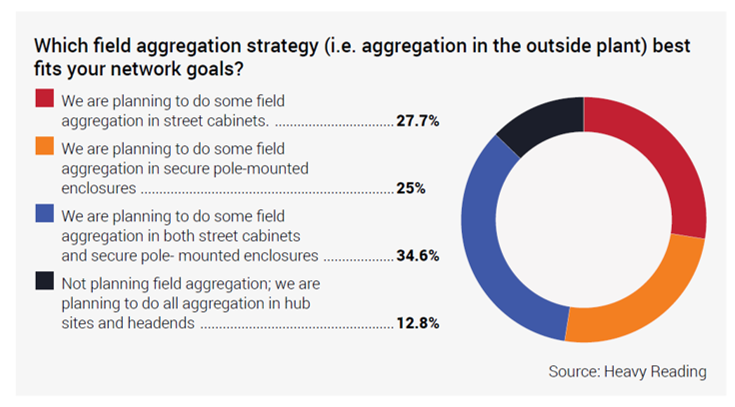
Ciena’s 5170/5171 platforms provide architectural flexibility regarding where MSOs can aggregate traffic in their access network, with the option for coherent backhaul to a hub site or headend. Learn more on why Cable MSOs Need Packet-based Networks for DAA and Extending Fiber Deep.
How will Converged Interconnect Networks leverage coherent optics?
Coherent optics provide the performance and flexibility to transport significantly more information on a given wavelength—an important technology within the CIN to achieve the performance and efficiencies expected from DAA. The Fiber Outlook Survey found that only ~8% of respondents don’t plan to use coherent optics in their CIN.
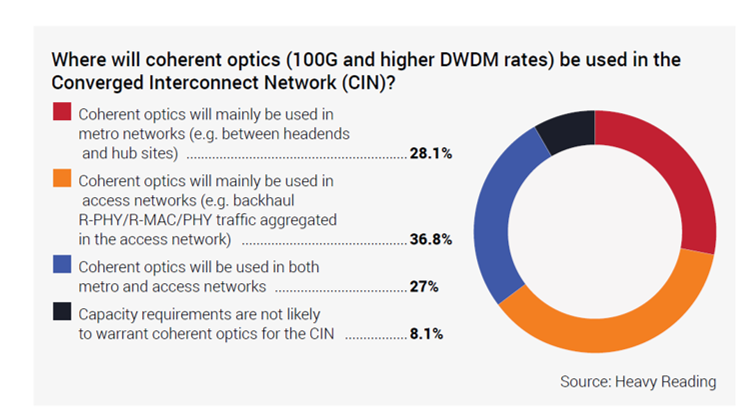
CFP2-DCO modules, such as Ciena’s WaveLogic 5 Nano 100G/200G CFP2-DCO enable MSOs to convert Ethernet to coherent optics in locations beyond a hub site, thereby providing architectural flexibility regarding where to aggregate traffic, with the option for coherent backhaul to the hub site or headend. Ciena is an active participant in the CableLabs P2P Coherent Optics Working Group, supporting the industry’s 100G coherent optics initiative for the access network. Read more on how coherent optics improve capacity, performance and competitiveness for cable MSOs.
Where is automation needed the most in DAA and the CIN?
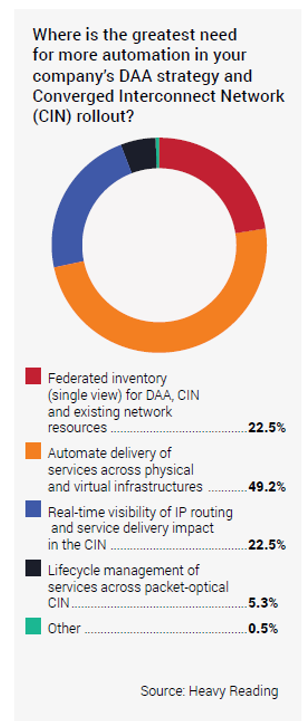 The Fiber Outlook Survey revealed that cable operators’ feel automating the delivery of services across physical and virtual infrastructures is the most pressing automation requirement, with ~49% of respondents identifying this as the greatest need. Having a single view of DAA, CIN and existing network resources, and, real-time visibility of IP routing and service delivery impacts were viewed as equally important, with ~23% of respondents identifying one of these as the greatest need.
The Fiber Outlook Survey revealed that cable operators’ feel automating the delivery of services across physical and virtual infrastructures is the most pressing automation requirement, with ~49% of respondents identifying this as the greatest need. Having a single view of DAA, CIN and existing network resources, and, real-time visibility of IP routing and service delivery impacts were viewed as equally important, with ~23% of respondents identifying one of these as the greatest need.
Blue Planet’s intelligent automation and lifecycle management software within the Ciena Fiber Deep solution for the Converged Interconnect Network provides the tools for MSOs to automate the delivery of services across physical and virtual infrastructures, offer a single view of DAA, CIN and existing network and service resources, and have visibility into routing behavior and impacts on services within the CIN.
Ciena’s Adaptive NetworkTM is our vision to empower MSOs to realize greater network agility, optimization, and real-time insight. It’s a transformation that begins now, regardless of where MSOs are in their journey toward digital transformation. Blue Planet software is fundamental to achieving the Adaptive Network, utilizing intelligent automation to eliminate manual operations and enable innovative new services.
Ciena’s Adaptive IPTM leverages the Adaptive Network vision to provide optimization and simplification to MSO IP networks, from access to metro. It leverages streaming telemetry to enable real-time monitoring of the network and services provided. Adaptive IP is based on a streamlined set of open protocols, like NETCONF/YANG, IS-IS, OSPF, and BGP, supporting new IP implementations, such as Segment Routing. It combines market-leading Packet Networking platforms with machine learning-powered analytics and intelligent automation software, cost-effectively enabling the MSO’s digital transformations to support new services and applications.
Download the DAA/CIN section of the Cable 2019 Fiber Outlook Survey Report for additional insights on where MSOs are at with their DAA and CIN strategies, including their views on converging multiple services on the CIN.
1For more information on demographics of the survey respondents please refer to the full report at Light Reading.





